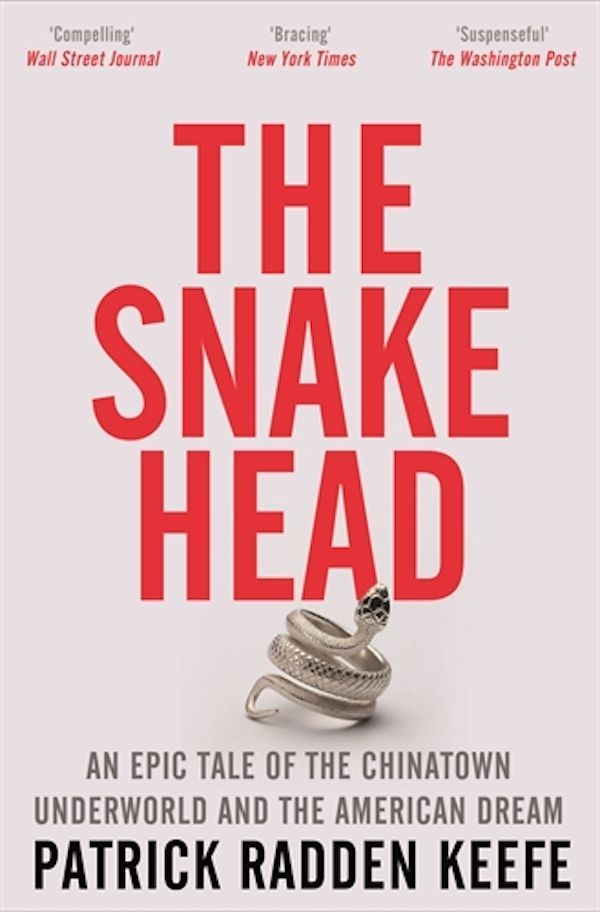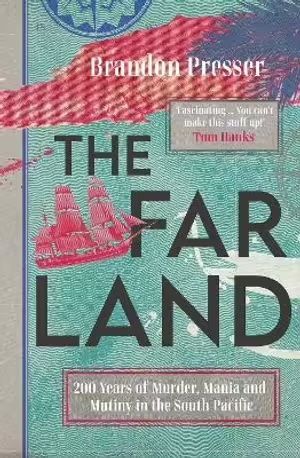The Snakehead
An Epic Tale Of The Chinatown Underworld and the American Dream
By Patrick Radden Keefe
Published by Pan Macmillan
ISBN 9781529099928
At first I presumed the title of the book was derogatory to the people who were labelled "Snakehead" but, thankfully, I was proved incorrect. 'Snakehead' is an adjective for the way in which people smugglers, especially Chinese people smugglers, conduct their business.
Like the head of a snake, they arrange transport for the many 'customers' waiting in safe houses en-route in various countries around the world, for transport to take them to the next safe house, like the body of a snake, twisting, turning and slithering across the globe.
'The Snakehead' commences with the narrative of a detailed account of a people-smuggling boat, a large coastal freighter, in the midst of a storm off the coast of New York. \The boat had collided with a sandbank, just off-shore, and all the passengers were in a mad panic to jump off the stricken boat into the freezing water, churned up by the storm, in the dead of night.
Clearly Patrick Madden Keefe undertook an enormous amount of research in which he reveals the inner workings of Cheng Chui Ping aka Sister Ping’s complex empire and recounts the decade-long FBI investigation that eventually brought her down He discusses members of the rescue teams, dives into their biographies in great detail, repeated for each new character in this real life thriller.
Many of the Chinese 'customers' perished and many more were taken into hospital, under custody and then transported to provincial prisons as undocumented, illegal immigrants. This was overseen by the United Immigration and Naturalization Service (INS) who were very stretched by budgetary constraints, working with the FBI and State Law Enforcement.
Keefe then explains the highly detailed history of the Chinese in America, starting with the 1849 Gold Rush. Due to this historic event, the Chinese called America "Golden Mountain" and word quickly spread in China. He explains that the Chinese people came across the Pacific to America in droves. They found work with the 'new' railways that started connecting the country together.
Most of these people came from a province on the east coast of China, called Fujian. These Fujianese became the majority of Chinese in the USA. Due to laws passed by the US Government in the early 20th century, the Chinese were excluded from many jobs which forced them to start their own businesses.
Meanwhile in China, the new People's Republic, established at the end of WW2, put in place laws that forbade people from travelling from their own home area for work, even within China, and caused many millions of small farmers to be stuck on the land.
As Keefe explains, n Fujian, a young girl named Cheng Chui Ping who became known as Sister Ping, was born and bred on a farm close to the sea, where her family had to eke out a living, due to the new 'Great Leap Forward’, Mao law. He decided that there were too many Chinese people and if some died as a result of his policies then so be it. Life was cheap. This gave her an underlying belief that she held throughout her life, that hard work was the only way to live and the belief that governments, authorities and officials did not care a jot for human life.
Due to relaxed laws after Mao died, she moved with her husband and children to Hong Kong where they opened a variety store, but she was restless and inspired by her father’s stories of living in the US after he had jumped ship years beforehand. He was caught after making a crucial error and was deported back to Fujian.
She applied for a visa at the US Embassy which was eventually granted. Sister Peng moved to Chinatown, New York, and worked hard to save enough money to call her family to join her. They opened a variety store in the Fujianese part of Chinatown, where she became an important member of the community, giving free advice and friendship to all the Fujianese who lived there. She even gave loans to certain people and expected repayment as and when they could afford it.
Keefe dives deep into the history of Chinatown and the 'tong' which were benevolent associations. Teenage gangs, became part of the tongs, when the illegal side of the tong businesses needed to be farmed out.
Meanwhile back in China, another Fujianese was eager to work in New York and he asked around for someone who could help him. He was put in touch with Sister Ping, who told him that she needed a deposit to be paid before he left and a guarantor in the US. Sister Peng told him to go to Guatemala, where, he was told to say with relatives who had found work for him.
We follow his journey through Hong Kong where he met other Fujianese, shepherded by Sister Ping's younger sister, Susan. They boarded a flight for Guatemala and were met by Sister Ping's brother, who took them to a safe house, where several others were waiting to go to Tijuana in Mexico close to the US border. Together with a few others he was smuggled over the border to Los Angeles, where he was met by Sister Ping, who gave him a ticket for his flight from LA to Jersey.
Upon arriving in Chinatown, Sister Ping asked him to phone his guarantor for the money. After receiving the money, she let him know where to find work and he started his new life in the US.
This is how she typically managed her business, although there were other factors involved when certain authorities became suspicious and she had to change routes and modes of transport with a few different routes operating at the same time, for the many hundreds of people waiting in safe-houses throughout the world.
Sister Peng became involved in transacting money transfers after one Fujianese wanted to send money back to his mother, but the Chinese Bank's charges were high and slow. She saw an opportunity to jump into this business provided a smaller fee than the banks charged and a far quicker service paid in US dollars.
With her various businesses, Sister Ping started to accumulate vast wealth, which she poured back into her community in China and became somewhat of a legend,to the inhabitants.
Keefe moves the story from country to country, introducing new personnel from the various agencies and the detailed history of their careers. Eventually, he returns to the beginning of the story of a Fujianese teenager called Sean Chen, who was fleeing his family home after physically assaulting a local official,.
This is a gripping true and complex story expertly told by Patrick Radden Keefe.He also writes about the current perspective of, not only American immigration, but immigration around the world, questioning if it ever can be stopped...
Snakehead is a jolly good read.
The author
Patrick Radden Keefe is an award-winning staff writer at The New Yorker and the author of Empire of Pain: The Secret History of the Sackler Dynasty - winner of the Baillie Gifford Prize for Non-Fiction, Say Nothing: A True Story of Murder and Memory in Northern Ireland, as well as two previous critically-acclaimed books, The Snakehead, and Chatter.
This is independent review, I am not paid by the publishers, so.If you
Liked this review - Buy me a coffee










